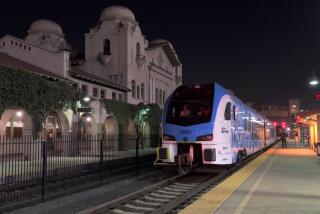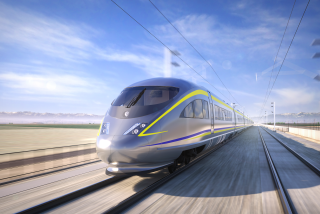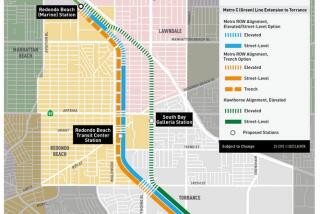Amtrak Balks on New Trains : Transportation: The agency says it cannot afford to upgrade service on the busy L.A.-San Diego run.
WASHINGTON — Top Amtrak officials said Wednesday that they cannot afford to add trains on the Los Angeles-San Diego rail corridor, the nation’s second-busiest passenger route, or replace aging signal equipment that is playing havoc with service.
In a meeting with representatives of a tri-county agency that is seeking to improve service along the 125-mile corridor, Amtrak officials said that they may not have enough money this year to cover existing service, much less the expense of adding trains or making system improvements.
The news was a setback for the Los Angeles-San Diego Rail Corridor Agency, which was formed seven months ago by the state and Los Angeles, Orange and San Diego counties.
The Tustin-based agency had hoped to persuade Amtrak to begin work on signal improvements, which would cost an estimated $15 million, and to provide additional train service along the busy route.
Eight passenger trains currently make daily round trips on the corridor, which serves nearly 2 million passengers a year. A round-trip fare between San Diego and Los Angeles is $30.
“We desperately need a new (signal) system to replace an outmoded system that’s breaking down almost daily,” said Sharon Greene, executive director of the rail corridor agency.
When the signal system fails, trains are restricted to speeds of 15 m.p.h. As a result, Greene said, the failures “are contributing to unreliability and loss of ridership.”
Statistics provided by Greene’s agency indicate that ridership during each of the first nine months of 1989 has declined from 1988. For example, monthly ridership last August was about 180,000, down from 190,000 in August, 1988. One of the eight daily trains also serves Santa Barbara.
Tim Gillespie, Amtrak vice president for government affairs, said the agency “would like to be as helpful as we can be out there (in Southern California) . . . but the question is, is there a way to provide the service without increasing our federal budget deficit?”
“We currently . . . don’t have enough money to continue operating everything we’re operating today,” he said.
Gillespie, Amtrak President W. Graham Claytor Jr. and other Amtrak officials met with Greene; James Mills, chairman of the tri-county rail agency, and Jackie Bacharach, the agency’s vice chairman.
According to Greene, the Amtrak officials said there was not enough money available to make even minor improvements needed to improve the reliability of the service.
She said her agency would work with Amtrak to look for money from Congress and other sources to make the necessary improvements.
Greene said the tri-county group did not broach the subject of seeking another public or private group to operate rail service along the Los Angeles-San Diego track, which is owned by the Atchison, Topeka & Santa Fe Railway System. The agency decided earlier this month to explore that possibility.
“I think clearly the state and the agency should know what their options are,” Greene said. “As to whether a change in operator would be pursued is another question. At this point, I don’t think that anybody knows seriously what the options are.”
In addition to raising the issue of signal improvements and other major repairs, the California rail agency officials renewed their pitch to place more trains on the Los Angeles-San Diego run.
But the Amtrak officials were not receptive, officials on both sides said.
“We have established a goal of covering all of our costs (through passenger fare receipts and other charges) by the year 2000,” Gillespie said. “To do that, we can’t be running around adding new subsidies . . . by initiating routes that won’t pay for themselves.”
At the heart of the debate is a fundamental disagreement between Amtrak and the California rail agency over the definition of profitability.
Four of the eight trains that serve the Los Angeles-San Diego corridor are operated under an agreement in which Caltrans assumes some of the loss if the trains do not pay for their own operating costs.
Using one measure of short-term costs, the four trains take in revenues that cover all operating costs and contribute an additional 7% surplus to Amtrak.
The state rail agency argues that the 7% surplus ought to be applied to the cost of operating additional trains under the loss-sharing agreement with Caltrans.
However, Amtrak argues that under another formula for calculating long-term costs, the four state-sponsored trains actually lose money. Therefore, Amtrak’s policy is that any new rail service between San Diego and Los Angeles would have to be self-supporting.
More to Read
Sign up for Essential California
The most important California stories and recommendations in your inbox every morning.
You may occasionally receive promotional content from the Los Angeles Times.









